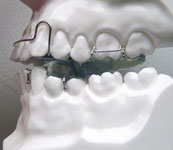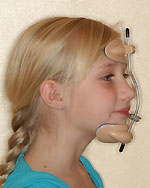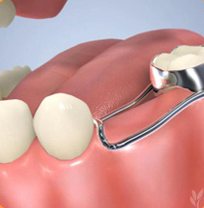
Twin Block Appliance
This is an appliance designed to promote forward growth of the lower jaw. It is removable instead of fixed. It consists of an upper and lower retainer with large blocks of acrylic.
When the retainers are in the mouth, the patient must move the lower jaw forward in order to comfortably close. The retainers must be worn full time for nine to 12 months, and braces typically follow the appliance treatment.

Facemask
This is a type of headgear used for growing patients with an underbite (Class III). It is worn at night to help encourage forward growth of the upper jaw to better match the position of the lower jaw. Rubber bands connect to hooks on a Rapid Palatal Expander that is cemented to the upper teeth. Usually, the facemask is worn for six to 12 months.

Space Maintainers
If your child’s tooth has come out too soon because of decay or an accident, it is important to maintain the space to prevent future space loss and dental problems when permanent teeth begin to come in.
Without the use of a space maintainer, the teeth that surround the open space can shift, and impede the permanent tooth’s eruption. When that happens, the need for orthodontic treatment may become greater.
Types of Space Maintainers
Space maintainers can be made of stainless steel and/or plastic and can be removable or fixed (cemented to the teeth).
Removable: A removable space maintainer looks much like a retainer with plastic blocks to fill in where the tooth is missing. If your child is older and can reliably follow directions, a removable space maintainer can be a good option.
Fixed: Fixed space maintainers come in many designs.
A band-and-loop maintainer is made of stainless-steel wire and held in place by a crown or band on the tooth adjacent to the empty space. The wire is attached to the crown or loop and rests against the side of the tooth on the other end of the space.
A lingual arch is used on the lower teeth when the back teeth on both sides of the jaw are lost. A wire is placed on the lingual (tongue) side of the arch and is attached to the tooth in front of the open space on both sides. This prevents the front teeth from shifting back into the gap.
In the case of a lost second primary molar prior to the eruption of the first permanent molar, a distal shoe may be recommended. Because the first permanent molar has not come in yet, there is no tooth to hold a band-and-loop space maintainer in place. A distal shoe appliance has a metal wire that is inserted slightly under the gum and will prevent the space from closing.